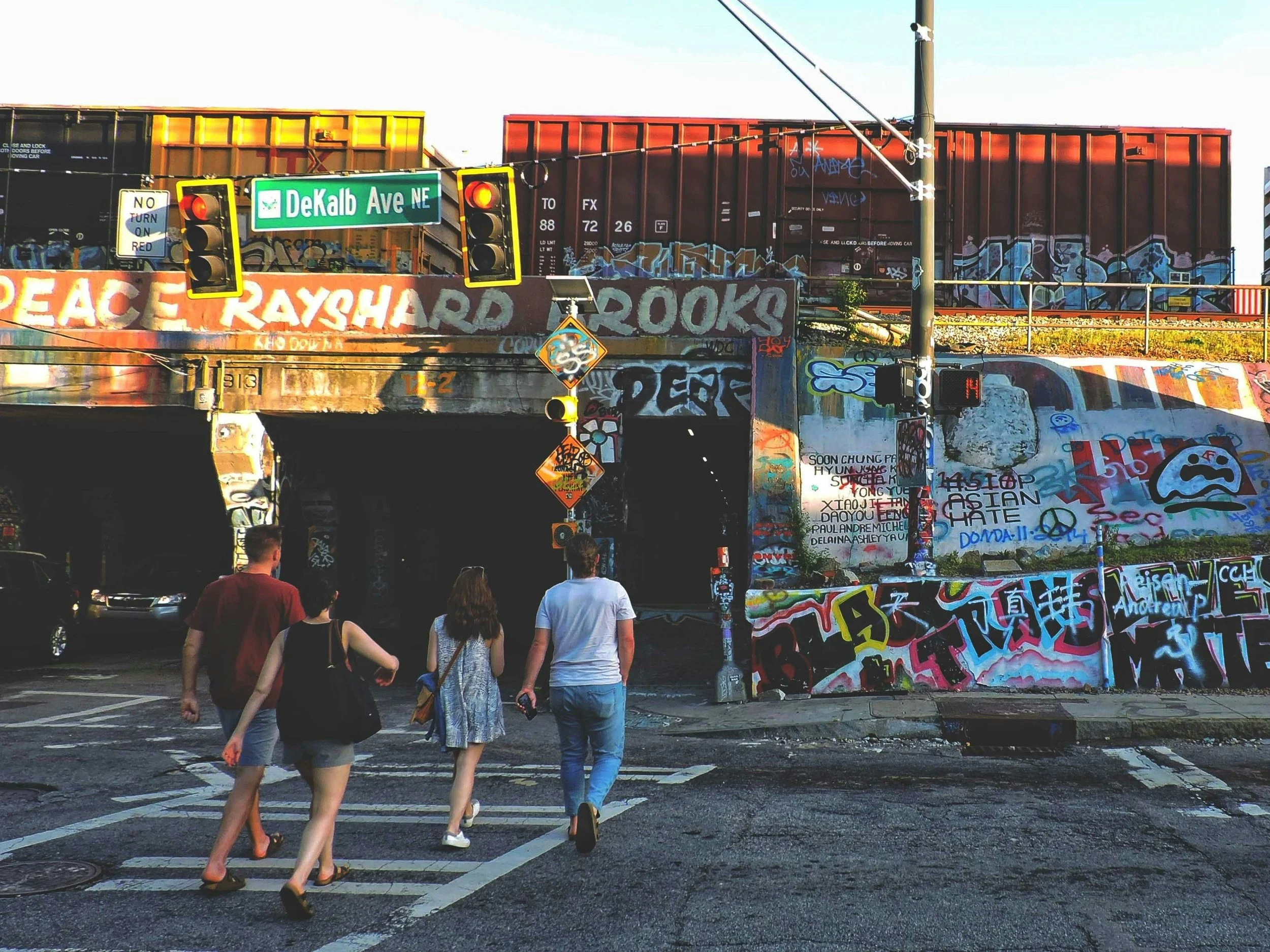Balancing Growth and Equity: The Promise and Challenges of the BeltLine Rail Expansion
Atlanta’s BeltLine project is one of the most ambitious urban redevelopment initiatives in the United States, at the epicenter of the city’s rapid growth into a dynamic and innovative urban center. The 22-mile loop of Atlanta's historic, now-abandoned freight rail track, around which planners built the BeltLine, now boasts about 10 miles of multi-use trails for cycling, walking, or jogging, surrounded by a mix of new housing developments, repurposed buildings, and thriving businesses. The long-term plan for the line envisions expanding Atlanta’s streetcar network, installing European-style grassy tracks around the loop, and constructing more multi-use pathways alongside new retail and housing complexes. Projections indicate that this project will enhance transit accessibility for thousands of Atlanta residents and mitigate the climate impact of the rapidly growing metro area. Still, many oppose the installation of the streetcar tracks along the line for a series of cost, gentrification, and lifestyle-related reasons.
Installing the Atlanta streetcar along the BeltLine would open up transit access to the 45 neighborhoods that surround the BeltLine corridor and serve nearly a quarter of the city’s population. This would, without a doubt, make it easier for anyone in the corridor to access the amenities quickly developing around the BeltLine, which could particularly interest the southern and western populations of Atlanta, who, on average, own fewer cars and depend more on public transit than the rest of the city. Continued BeltLine development along the Eastside Trail could also be excellent for job growth—data shows the BeltLine has created over 29,500 jobs as of 2024, 59% of its 50,000 job goal for the totality of the project. Additionally, the Federal Highway Administration (FHWA) has projected that the BeltLine’s construction and growth will create over 50,000 new housing units, 5,600 new workforce housing units, and 1,300 acres of new green space and parks.
Furthermore, the development of the BeltLine also incorporates environmentally conscious values, as planners and advocates aim to enhance Atlanta's status as a green city of the future. One expectation is that the expansion of green space into urban areas will alleviate the urban heat islands that the city of Atlanta creates. Areas with higher-than-usual proportions of concrete and asphalt, typically in major cities, create heat islands by drawing in and holding more heat, leading to higher temperatures across the region. More green space and shade can help cool the area and prevent evapotranspiration, reducing Atlanta’s impact on climate change. Further expansion of this green space is also expected to help mitigate stormwater runoff. Specifically, the Historic Fourth Ward Park, one of the many parks along the BeltLine, features a two-acre detention pond capable of holding up to 4 million gallons of water. Projections indicate that this will significantly contribute to reducing stormwater runoff and alleviating the current strain on the city's sewer system, a situation that has only gotten worse as the metro area grows. Parks with similarly positive environmental impacts, such as the Westside Reservoir Park, are still under construction. This park, part of the BeltLine's Westside Trail, aims to supply emergency drinking water to the city as well as mitigate stormwater runoff. In addition to the construction of new green space, studies consistently demonstrate that light rail developments alleviate traffic congestion throughout Atlanta, thereby lowering greenhouse gas emissions. This is in line with the city’s long-term sustainability goals to improve air quality and lower emissions, as well as being crucial to reducing congestion, which has become a more severe issue as people are moving to the Atlanta metro area in near-unprecedented waves.
Outspoken critics of the BeltLine rail addition have expressed concern over the cost of the project, particularly if funding could come out of other transit-related city projects. These concerns are not unfounded, as the Metro Atlanta Rapid Transit Authority (MARTA) Board of Directors’ Planning and Capital Programs Committee projects just the initial Eastside rail installation alone to cost around $230 million. Atlanta's 40-year MARTA half-penny sales tax and the existing 1% MARTA sales tax in Fulton, Clayton, and DeKalb counties, which increases to 1.5% within Atlanta, will provide this funding. The Georgia General Assembly approved the half-penny tax in 2016, projecting it to generate $2.5–$3.5 billion for MARTA development, including the streetcar. Officials currently do not anticipate needing additional taxes to complete the project, but given the increasing costs of the project, it might be necessary to reconsider the initial allocation of funds for rail installations. These installations could take money away from or delay other projects, such as adding more bus rapid transit lines and rail infill stations. These existing MARTA initiatives, aimed at maintaining and improving current infrastructure and expanding transit access, serve thousands of Atlanta residents.
While some data shows the BeltLine streetcar expansion to be positive for Atlanta’s growth, it is important to understand the possible harmful impact construction of a project of this nature could have on the existing city. The Urban Displacement Project’s (UDP) Displacement, Gentrification, and Exclusion Map of Atlanta, which rates areas across Atlanta by risk of gentrification, is a useful tool to assess the BeltLine’s impact. The map reveals a phenomenon known as "green gentrification," which involves the removal of existing communities to make way for the expansion of public green spaces. This trend is prevalent nationwide and could potentially pose a significant risk to the southern and western regions of the BeltLine corridor. Green gentrification, as well as new economic developments pricing current residents out of their homes, has caused major concern among opponents of the project.
Several other U.S. cities have implemented similar projects to the BeltLine, transforming previously obsolete infrastructure into public green spaces. Consideration of the risks of gentrification posed by other similar projects, such as New York's High Line and Chicago's 606, led to the creation of the Houston Bayou Greenways 2020 project, an expansion of green space installed in collaboration with local communities to ensure that it serves them best. Housing prices around developments in New York and Chicago have skyrocketed, leading to the uprooting of many previous residents. In contrast, the Bayou Greenways project emphasizes anti-displacement by involving local communities in its design, prioritizing support for these neighborhoods over imposing costly, disruptive developments. If the UDP’s data is any indicator, Atlanta could be trending to look more like New York and Chicago rather than Houston. BeltLine planners may want to consider further involving local communities in the planning process in order to mitigate potential harms while boosting the project's overall support and popularity among residents.
To date, the BeltLine has been a massive success, attracting millions of visitors per year, with projections expecting this number to rise. Historically, increased investment has consistently enhanced the project's progress and quality. Expanding pathways has spurred the growth of businesses and housing, ultimately improving residents' quality of life. The BeltLine’s development is still not without consequences, as other MARTA projects have faced delays, and housing prices in areas seeing new BeltLine construction have seen major hikes. Building the line with the city, not on top of it, is the most crucial aspect for Mayor Dickens and all those involved in the BeltLine project. This could involve collaboration with communities, similar to the Bayou Greenways project in Houston, to integrate the rail into the city in a way that benefits the people of Atlanta, rather than solely to attract outside visitors or investors. Still, opposition could easily quiet down should the people of Atlanta see the project for what it could be—an environmentally progressive, opportunity-opening mission for the future. This is possible, but it will require planners to act firmly and consistently in Atlanta's best interests.

